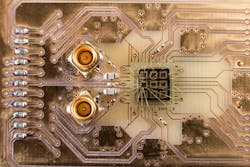University researchers eye quantum computing with SWaP small enough for future military missions
ARLINGTON, Va. – U.S. military researchers needed new ways of improving high-performance computing performance by at least two orders of magnitude using quantum computing techniques called quantum-inspired solver systems. They found their solution from the University of Rochester in Rochester, N.Y.
Officials of the U.S. Defense Advanced Research Projects Agency (DARPA) in Arlington, Va., announced a $1.6 million contract to University of Rochester on Friday for the Quantum-Inspired Classical Computing (QuICC) program.
Quantum computing harnesses the phenomena of quantum mechanics to deliver a huge leap forward in computation to solve certain problems.
University of Rochester experts will develop quantum-inspired solver systems that solve realistic problems for military missions. Quantum-inspired solvers are hybrid: they are classical mixed-signal systems that consist of analog hardware and digital logic.
The analog hardware typically emulates interacting dynamic systems, and the digital logic processes the analog results to obtain quality solutions.
The objective is to deliver system prototype that can improve computational efficiency by at least 50 times for intermediate problem sizes and to show the feasibility of improving efficiency by at least 500 times for mission-scale problems.
The QuICC program will focus on classical hybrid mixed-signal systems; all-digital solvers or quantum computing are not part of the program.
Many U.S. Department of Defense (DOD) missions are limited by available computing resources. Quantum computing may be a potential solution, yet there is nothing to suggest that quantum computing every will be feasible for military size-, weight-, and power- (SWaP)-constrained environments.
Detailed analysis of quantum computing has led to new algorithms and hardware, while delivering significant advantages over all-digital computing. This is where quantum-inspired solvers may come in.
Quantum-inspired analog hardware typically emulates interacting dynamic systems like magnetic spins, and the digital logic processes the results.
Experts predict that prototype quantum-inspired could outperform conventional and quantum computers by a factor of 10,000, but have been demonstrated on small problems not typical of what the military needs.
A key QuICC metric for University of Rochester experts will be computational efficiency. To overcome scaling challenges, the program seeks solutions with algorithmic and analog hardware co-design, alongside application-scale benchmarking applications like Boolean satisfiability (SAT), maximum likelihood estimation (MLE), maximum-fault minimum-cardinality (MFMC) sampling, and mixed-integer linear programming (MILP).
Related: Artificial intelligence and embedded computing for unmanned vehicles
The program has three technical challenges: scaling analog hardware advantages to mission relevant problems; limiting the growth of digital computations with problem size; and realizing predictive benchmarks at prototype system scales.
The QuICC program is five-year effort with a two year first phase, an 18-month second phase, and an 18-month, and an 18-month optional third phase. The program milestones will advance the scaling of quantum-inspired solver technology progressively toward mission-relevant problems and sizes.
The QuICC project may spend as much as $58 million over its entire duration, so additional contracts are likely. The program comprises two technical areas: solver co-design and mission relevant benchmarking; and analog hardware prototyping.
For more information contact University of Rochester online at www.rochester.edu/research/technology.html, or DARPA at www.darpa.mil.
About the Author
John Keller
Editor-in-Chief
John Keller is the Editor-in-Chief, Military & Aerospace Electronics Magazine--provides extensive coverage and analysis of enabling electronics and optoelectronic technologies in military, space and commercial aviation applications. John has been a member of the Military & Aerospace Electronics staff since 1989 and chief editor since 1995.
